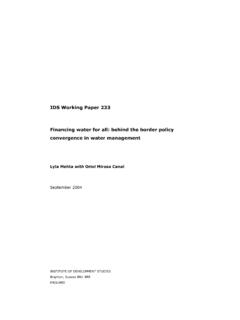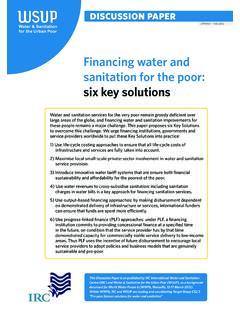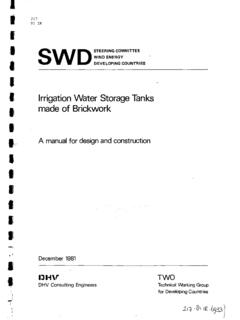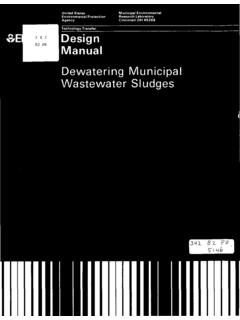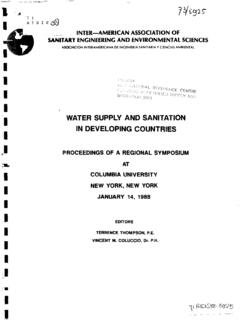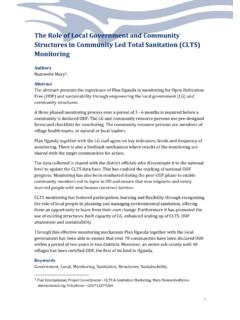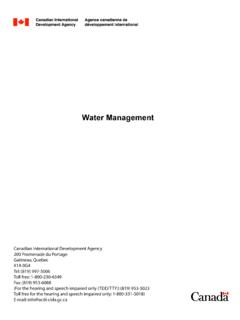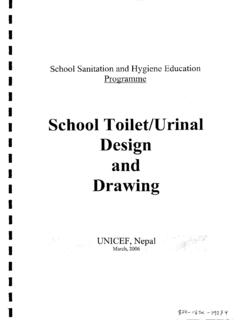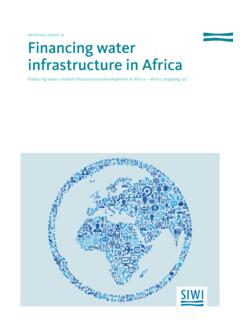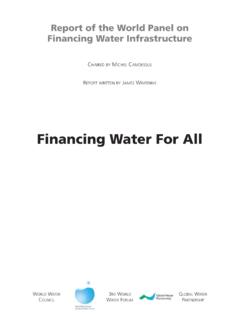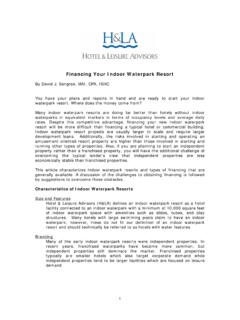Transcription of Financing water and sanitation - ircwash.org
1 Financing water and sanitationFinancing water and sanitationFinancing water and sanitationFinancing water and sanitation Key issues in increasing resources toKey issues in increasing resources toKey issues in increasing resources toKey issues in increasing resources tothe sectorthe sectorthe sectorthe sector A WaterAid briefing paper written byA WaterAid briefing paper written byA WaterAid briefing paper written byA WaterAid briefing paper written by S. Annamraju, & Annamraju, & Annamraju, & Annamraju, & 2001 November 2001 November 2001 November 2001 WaterAid Financing water and sanitation2 SUMMARYSUMMARYSUMMARYSUMMARYW ater and sanitation struggle to receive funding in the developing world, wheregovernments are pressed with struggling economies, huge debts and a host of othersocio-political problems.
2 Most often, they have to prioritise other basic social services,such as education and health, over water and sanitation . In general developing countriesspend anywhere between 1% and 3% of government budgets on low cost water report looks at the different sources of finance available for the global water andsanitation sector and how the Financing gap can be filled to achieve universal , it is estimated that some US$27-30 billion is spent annually on the water andsanitation sector in developing countries.
3 Of this amount, close to 70% come from thedomestic public sector. A further 20% come from international aid flows, and theremaining 10% come from international private sector and , these current levels of spending are woefully inadequate. It has beenestimated that if international development targets of halving the number of peoplewithout access to water and sanitation are to be met by 2015, a further US$25 billioneach year is needed on top of what is already being spent.
4 Of this amount, sanitationneeds to be prioritised, taking as much as US$17 billion, with the rest going to watersupply. The Financing problem therefore, can be stated as: How can current levels ofspending at US$27-30 billion for water and sanitation at the global level be sustained,while securing an additional US$25 billion per year, of which sanitation gets the priority?This problem is mainly an international problem and not just a problem of the concerneddeveloping countries.
5 For instance, a most important measure to address the problem isdebt relief it can provide governments in Africa, some of which spend up to 60% oftheir national budget on foreign debt service payments, with already available the other hand, official development aid from member countries of the OECDD evelopment Assistance Committee amounts on average to only of theircombined GNP. If these donors can meet the UN agreed target of providing aidamounting to of GNP for only two years, it will eliminate the US$245 billion debt ofall 41 Highly Indebted Poor Countries.
6 There are a range of other sources of Financing from private sector Financing (bank loans and direct investments) to the reallocation ofcurrent government expenditures and to household and community Financing . These aresolutions that the international community needs to focus on. The political will necessaryto get a tight grip on the problems and implement the solutions needs to be report argues that contrary to current thinking, the private sector cannot fill theinvestment gap. The solution lies in the following three areas: 1) efforts should bedirected towards Northern governments, which should be lobbied to provide more officialaid.
7 2) Southern governments should be lobbied to increase their financial allocations tothe water and sanitation sector. 3) Further effort should be directed to both Northern andSouthern governments to recognise the investments that are currently (and will continueto be) made by communities and Financing water and sanitation3 Also, this report argues that where financial resources are available, a restructuring ofpublic sector expenditure is needed in order to improve delivery and coverage.
8 In someinstances, the problem has less to do with the absence of Financing than with issues ofhow to spend available funds more wisely and sustainably. This, again, is a matter ofpolitical will and of improving the governance of the briefing paper is one of a series which analyses policy issues that impact on thewater and sanitation sector. Other papers in the series are:A human rights-based approach to water , sanitation and hygieneA poverty-reduction approach to water , sanitation and hygiene programmesA gender and development approach to water , sanitation and hygiene programmesBoiling Point: Issues and problems in water security and sanitationWaterAidPrince Consort House27-29 Albert EmbankmentLondonSE1 7 UBTelephone: 020 7793 4500 Fax: 020 7793 4545 Email.
9 Financing water and sanitation4 List of AcronymsList of AcronymsList of AcronymsList of AcronymsADB- Asian Development BankCSD- Commission on Sustainable DevelopmentDAC- Development Assistance Committee (of the OECD)DFID- Department for International Development, UKESAF- Enhanced Structural Adjustment FacilityFfA- Framework for ActionGDP- Gross domestic productGEF- Global Environmental FundHIPC- Highly Indebted Poor CountryIMF- International Monetary FundNGO- Non-government organisationNPV- Net present valueO&M- Operation and maintenanceODA- Official development assistanceOECD- Organisation for Economic Co-operation and DevelopmentOPP- Orangi Pilot ProjectPPI- Private participation in infrastructurePRSP- Poverty Reduction Strategy PaperPSP- Private sector participationSSIP.
10 Small-scale independent providerUNDP- United Nations Development ProgrammeUNFPA- United Nations Population FundUNICEF- United Nations Children s FundWB- World BankWCD- World Commission on DamsWHO- World Health OrganisationWSS - water supply and sanitationWSSCC- water Supply and sanitation Collaborative CouncilWaterAid Financing water and sanitation5 CONTENTSCONTENTSCONTENTSCONTENTSI ntroductionIntroductionIntroductionIntro duction6 Financial flows to the water and sanitation sectorFinancial flows to the water and sanitation sectorFinancial flows to the water and sanitation sectorFinancial flows to the water and sanitation sector7 Investments in water -related infrastructure in developing countries8 International aid and credit flows for WSS9 International private sector flows 11 Domestic public sector flows in water supply and sanitation 12 Domestic private flows.
